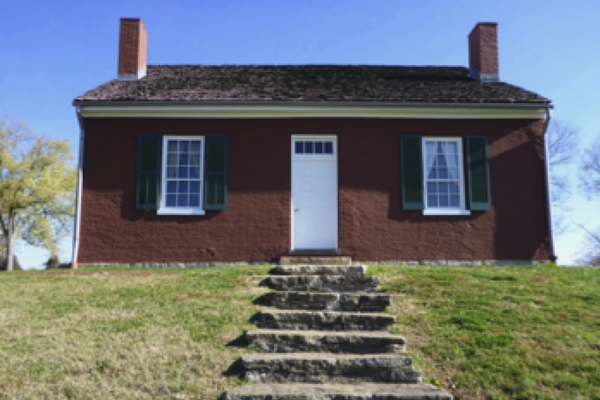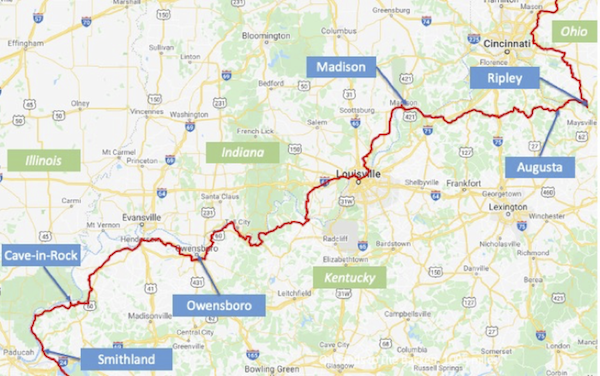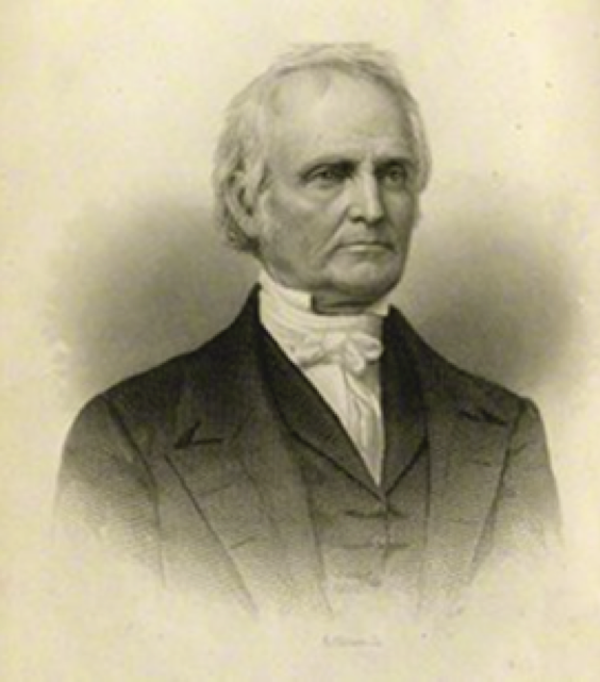The Heroes of Ripley, Ohio

The Rankin House, Ripley, Ohio (ripleyohio.net)
Excerpted from On Freedom Road: Bicycle Explorations and Reckonings on the Underground Railroad, by permission of Pegasus Books.
The traces of the Underground Railroad hide in plain sight: a great church in Philadelphia; a humble old house backing up to the New Jersey Turnpike; an industrial outbuilding in Ohio. Over the course of four years, David Goodrich rode his bicycle 3,000 miles east of the Mississippi to travel the routes of the Underground Railroad and delve into the history and stories in the places where they happened.
In this excerpt, as we pedal along with him, Goodrich brings us to the Borderland along the Ohio River, a kind of no-mans-land between North and South in the years before the Civil War. Here, slave hunters roamed both banks of the river, trying to catch people as they fled for freedom.
In the town of Ripley, Ohio, back when the Underground Railroad was operating, there lived a preacher up on the hill and a blacksmith down by the river. I had heard about the man on the hill, the hawk-nosed Presbyterian minister who hung a lantern in his window, and I’d come to town to learn about him. But the Black man down by the river who ran the foundry – well, he belongs as a comic book superhero.
I descended the bridge from Madison, Indiana, once again into the Bluegrass State, bound for Ripley, Ohio. My route veered away from the Ohio River and into the hills, cutting across the northern nub of the state that sticks up near Cincinnati. I paid dearly for that shortcut. As I lay down in bed on my Kentucky nights, my eyes were raw from the sweat that had gotten in them, banging up grade after grade. One climb even had its own sign – “Granny and Pa’s Hill.” Cute, but it was one more stinker.

Bicycle route through the Ohio River Borderland,
from Smithland, Kentucky to Ripley, Ohio.
My little motivational motto was “ten [miles] by nine [o’clock].” The reward for such industry was a second breakfast, should the opportunity arise. So it was that an oasis appeared out of the morning mist: in Falmouth, hard by the South Fork of the Licking River, rose a McDonalds. Across adjacent tables, I shared a few sea stories with an older man in a USS Essex ball cap. I casually dropped into the conversation that I was almost a thousand miles from my start in Mississippi. As I was getting ready to ride out of the parking lot, a car pulled up and the window rolled down. My breakfast companion had two twenties in his hand.
“Thank you, that’s very kind,” I said. “I don’t need it. I’m not doing this for a charity benefit. I’m fine.”
“A gift from the Navy,” he said.
Kentucky has wonderful people, but I was ready to leave the riding conditions behind. One scene repeated several times a day: Round a bend. House with a porch. Dog on the porch. Here he comes. I was getting a little low on pepper spray. I had a particularly large pit bull on me coming out of Dry Ridge until he got well-seasoned. I don’t know what it is that dogs like about cyclists, whether it’s the thigh or the drumstick. I’ve cycled in 35 states, and Kentucky’s dogs are the worst. Adding to my grievance list, the state transportation department is both fond of their rumble strips and parsimonious with their shoulders. So I resolved to cut my time in Kentucky short and spend one last night in Augusta.
Augusta is a graceful old town. Federal-style houses line the well-preserved waterfront, and the visitor’s center can be found in an old caboose. Singer Rosemary Clooney’s house is along the river, and her nephew George graduated from the local high school. Augusta contains fragments of the years before the Civil War, and of the losing battle against the spreading stain of slavery. I walked by a dormitory of the old Augusta College. The institution became the center of the antislavery movement in Kentucky and, as a result, the state legislature revoked its charter in 1849, forcing it to close its doors. John Fee, the abolitionist and founder of Berea College, was forced across the river to Ohio by a mob here. Kentucky’s largest mass escape of the enslaved ended here in 1848, when 42 freedom seekers were captured just south of town.
In Augusta, I stayed at an elegant bed and breakfast, the Parkview Inn, a nice change from my notorious standard-free accommodations. It was graduation night at the high school, and the town restaurant was filled with loud, celebrating families. My own final evening in Kentucky brought concentrated last-minute research on Bourbon.
Sadly, the next morning was bright, clear, and brutal. I reassembled my head and my bike and rolled down to the riverside. The ferry to Ohio had been running there since 1798, and the present tenant was a small, four-car operation. As I made my last crossing of the Ohio River, I was accompanied by a stowaway: the fever was just beginning as I stepped into the Buckeye State. It was to be my companion all the way to Pennsylvania.
In an earlier Ohio crossing in 1844, Calvin Fairbanks, a young seminarian from Oberlin, was on the ferry to Ripley. He noticed a man crossing in a skiff and hailed him.
“Mister, are you a Kentuckian?”
The man replied that he was. Pointing to Ripley, Fairbanks asked, “Well, what kind of place is this?”
“It is a black, dirty, abolition hole, sir.”
Fairbanks asked the man to show him the homes of abolitionists. He pointed to a red brick farmhouse on a bluff above the town. “Dr. Rankin occupies the one on the hill.”
John Fee was not the only one driven out of Kentucky by pro-slavery forces. John Rankin was a minister in the eastern part of the state but was quickly disabused of the notion that he could preach to the enslaved. He moved across the river to Ripley, where the local Presbyterian church had invited him to serve as pastor. He would ultimately build the house on the hill, which still stands today, gazing out over the river.
I checked into the bed and breakfast in Ripley but didn’t stay long. From the riverside, I climbed the stone staircase up to the ridge above town. The stairs are known as the Hundred Steps to Freedom, and at the summit sits the Rankin House, a National Historic Landmark. I turned to see the same dramatic view of the seven bends of the Ohio that John Rankin had looked upon each night. The flinty-eyed preacher would scan the dark hills across the river for men on horseback and would light the lantern in the window if the passage appeared safe. According to his autobiography, he and his family assisted about 2,000 freedom seekers on their way north. The guide inside the Rankin House on this day was an earnest young high school girl with ties to the past. Her great-great grandfather had been enslaved.

Rev. John Rankin (Cincinnati Museum Center)
The Rankins made it a habit to leave the door unlocked and a fire going at night in case there were visitors. In the small hours one winter evening, Rankin found a Black woman and her baby huddled by the fire trying to dry off. As they fed her and gave her dry clothes, she told her story. She had escaped across the frozen Ohio River, pursued by slave hunters until she ran out on the soft ice. She fell through several times, managing to keep her baby out of the water and using a fence rail that she carried to climb out. Somehow she made it across and up the hundred steps to the Rankin House. Rankin’s family helped her – like many others before and after – on her way to Canada.
The woman and her child disappeared into the Underground Railroad but not from history. Rankin later told the story to Calvin Stowe, one of his son’s professors at the Lane Seminary in Cincinnati. Listening quietly was Calvin’s wife Harriet. Harriet dubbed her Eliza, and the tale of mother and child on the ice floes would find its way into Uncle Tom’s Cabin, the bestselling American book of the nineteenth century. In the years before the Civil War, virtually every literate person in the country knew Eliza’s story.
Rankin endured attacks at his house by slave hunting gangs and assaults by mobs during his abolition lectures, but he had one advantage over the Black abolitionists like
George DeBaptiste: his race. He had a substantial support network among white abolitionists reaching all the way to New England. And he never had to risk enslavement as a result of his actions. Down the hill in Ripley, however, was a man who did: running the town foundry by day and crossing the river into Kentucky by night was John Parker, whose house also stands today.
Parker was born in Virginia, and as a young boy was marched south in a coffle of 400. In his autobiography he describes the journey:
It was in June that I began my chainbound journey to Alabama, where I eventually reached. Our journey was long and tiresome. Imagine yourself chained to a long chain to which men, women and children were also attached…I was trudging along a trail called a road through the mountains of Virginia. Every flower was in bloom, the wilderness was all about us, green and living. Azaleas and mountain laurels were in full bloom. Every thing seemed to be gay except myself. Picking up a stick, I struck each flowering shrub, taking delight in smashing down particularly those in bloom.
In Alabama, Parker was lucky enough to avoid the cotton fields and learn the foundry trade. Amazingly, he was able to earn money on the side, enough to secure his freedom. Moving north, he settled by the river in the bustling town of Ripley, with the Kentucky shore just across the water. What followed were the tales of a Black superhero. He made repeated forays across the river to lead out groups of the enslaved. Some, like Harriet Tubman, survived such journeys, and others, like Elijah Anderson, did not.
Parker had his close calls. One day his contact across the river told of a party of ten freedom seekers from central Kentucky camped in the woods, lost. His contact led him to the group. Like Tubman, Parker carried a gun less for protection and more to keep his charges in line. He proceeded to lead them through the forest, avoiding roads in the Borderland, which were sure to be patrolled. At the riverbank the baying hounds picked up their scent as they frantically searched for a boat. But the one they found could not fit them all. As they approached the Ohio shore, they watched as lights converged on the two left behind.
In another instance, Parker developed a friendship with an enslaved man and his wife and had resolved to help in their escape. But their enslaver became suspicious and insisted that they bring their baby to him each night to sleep in his bedroom in the big house. Late one night, amid creaking floorboards and squeaking hinges, Parker crept past the headboard to where the crib lay. He grabbed the baby and bolted. With bullets flying overhead, he and the couple ran for the river and to the safety of Parker’s skiff.
Parker became notorious in Kentucky. So it was not surprising that during one of his expeditions, he read, nailed to a tree: Reward $1000 for John Parker, Dead or Alive. Seeing the poster reinforced his caution. He burned his diary of the 440 freedom seekers he had assisted, and he never allowed anyone to take a photograph of him.
After the Civil War, Parker became a successful businessman in Ripley, running his foundry and blacksmith shop. He was one of the few African Americans to hold patents, in his case for agricultural implements. In the 1880’s, he began to tell his stories to a Tennessee reporter. He was an old man, perhaps telling tall tales, as we old men do. Some are documented, but Parker never knew the names of many of the people he rescued. But if half of them were true, the Ripley waterfront holds the memory of an American hero.
Trying to ignore my growing fever, I stopped by the John Parker House, just down the street from my bed and breakfast. Dewey Scott, a big, deep-voiced Black man who is the docent and historian there, paced in front of the white fireplace telling some of Parker’s stories. I had a particular question for him.
“I’ve been riding for a while on an Underground Railroad route, staying in motels,” I said. “How did people escaping from slavery ever make it to the Ohio without benefit of food or shelter along the way?”
“Many didn’t, of course. And many were sheltered in the community along the way,” he said. “But one secret was corn.”
“Corn?” I asked.
“A mature corn field provides both food and an almost impenetrable hiding place. Running in midsummer would mean following the maturing corn while traveling north.”
As I wandered back to the B&B along the river, I could feel my fever beginning to spike. I wondered how I was going to be in any shape to ride the next day. Betsy and Vic Billingsley, the innkeepers, had to leave for a family graduation that night. Incredibly, they stocked the refrigerator and let me stay the next day on my own.
“Just lock the door when you go,” she said.
I was better after a day under their warm quilts. I figured that I could treat flu like I always had: Sleep like crazy for a day or two, then just live with it until it goes away. That model worked well for a desk job but less so for 60 miles a day on the road. On the morning after my rest day, I rolled out of the Ripley Borderland and into central Ohio and storm clouds.